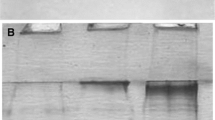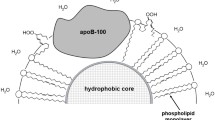Abstract
It was found that glucose in the range of concentrations 12.5–100 mM stimulated Cu2+–mediated free radical peroxidation of low-density lipoproteins (LDL) from human blood plasma. Considering the kinetic parameters of LDL peroxidation we proposed that intensification of this process may be caused by formation of free radical intermediates of glucose auto-oxidation. Addition of SOD to the medium inhibited LDL oxidation, indicating the formation of superoxide anion-radicals under autoxidation of glucose. Similarly, SOD inhibited free radical peroxidation of liposomes from egg lecithin in the presence of glucose that confirms the generation of superoxide radicals under co-oxidation of unsaturated lipids and glucose. Normalization of glucose level in the blood of patients with type 2 diabetes mellitus during therapy was accompanied by a significant decrease in LDL oxidation in vivo (the decrease in primary and secondary lipoperoxidation products). The formation of superoxide anion-radicals was observed during interaction of aminoacid l-lysine with a product of glucose oxidative metabolism–methylglyoxal, but not with a product of lipoperoxidation malonyldialdehyde. In accordance with the foregoing the administration of sugar-lowering drug metformin, which binds and utilizes methylglyoxal, caused a stronger inhibition of LDL peroxidation in the blood of patients with diabetes mellitus, probably due to decrease in methylglyoxal-dependent generation of superoxide anion-radicals. Based on the results we set out the hypothesis about autocatalytic mechanism of free radical reactions involving natural dicarbonyls and suppose the common molecular mechanism of vascular wall injury in atherosclerosis and diabetes.








Similar content being viewed by others
References
Witztum JL, Steinberg D (1991) Role of oxidized low density lipoprotein in atherogenesis. J Clin Invest 88:1785–1792
Schwartz CJ, Valente AJ, Sprague EA, Kelley JL, Nerem RM (1991) The pathogenesis of atherosclerosis: an overview. Clin Cardiol 14:11–16
Yla-Herttuala S (1994) Role of lipid and lipoprotein oxidation in the pathogenesis of atherosclerosis. Drugs Today 30:507–514
Lankin VZ, Tikhaze AK et al (2003) In: Tomasi A (ed) Free radicals, nitric oxide, and inflammation: molecular, biochemical, and clinical aspects, NATO Science Series, vol 344. IOS Press, Amsterdam, pp 218–231
Lankin VZ, Tikhaze AK, Kapel’ko VI, Shepel’kova GS, Shumaev KB, Panasenko OM, Konovalova GG, Belenkov YN (2007) Mechanisms of oxidative modification of low density lipoproteins under conditions of oxidative and carbonyl stress. Biochemistry (Moscow) 72:1330–1341
Willcox BJ, Curb JD, Rodriguez BL (2008) Antioxidants in cardiovascular health and disease: key lessons from epidemiologic studies. Am J Cardiol 101:75D–86D
Oberley LW (1988) Free radicals and diabetes. Free Radic Biol Med 5:113–124
Niedowicz DM, Daleke DL (2005) The role of oxidative stress in diabetic complications. Cell Biochem Biophys 43:289–330
Witz G (1989) Biological interactions of alpha, beta-unsaturated aldehydes. Free Radic Biol Med 7:333–349
Donato H (1981) Lipid peroxidation, cross-linking reactions, and aging. In: Sohal RS (ed) Age pigments. Elsevier, Amsterdam, pp 63–81
Baynes JW (1991) Role of oxidative stress in development of complications in diabetes. Diabetes 40:405–411
Thorpe SR, Baynes JW (1996) Role of the Maillard reaction in diabetes mellitus and diseases of aging. Drugs Aging 9:69–77
Furth AJ (1997) Glycated proteins in diabetes. Br J Biomed Sci 54:192–200
Monnier VM, Mustata GT, Biemel KL, Reihl O, Lederer MO, Zhenyu D, Sell DR (2005) Cross-linking of the extracellular matrix by the maillard reaction in aging and diabetes: an update on “a puzzle nearing resolution”. Ann NY Acad Sci 1043:533–544
Esper RJ, Vilarino JO, Machado RA, Paragano A (2008) Endothelial dysfunction in normal and abnormal glucose metabolism. Adv Cardiol 45:17–43
Tertov VV, Kaplun VV, Dvoryantsev SN, Orekhov AN (1995) Apolipoprotein B-bound lipids as a marker for evaluation of low density lipoprotein oxidation in vivo. Biochem Biophys Res Commun 214:608–613
Esterbauer H, Striegl G, Puhl H, Rotheneder M (1989) Continuous monitoring of in vitro oxidation of human low density lipoprotein. Free Radic Res Commun 6:67–75
Lankin VZ, Lisina MO, Arzamastseva NE, Konovalova GG, Nedosugova LV, Kaminnuyi AI, Tikhaze AK, Ageev FT, Kukharchuk VV, Belenkov YuN (2005) Oxidative stress in atherosclerosis and diabetes. Bull Exp Biol Med 140:41–43
Spiteller G (2008) Peroxyl radicals are essential reagents in the oxidation steps of the Maillard reaction leading to generation of advanced glycation end products. Ann NY Acad Sci 1126:128–133
Nourooz-Zadeh J, Tajaddini-Sarmadi J, Wolff SP (1994) Measurement of plasma hydroperoxide concentrations by the ferrous oxidation-xylenol orange assay in conjunction with triphenylphosphine. Anal Biochem 220:403–409
Hermes-Lima M, Willmore WG, Storey KB (1995) Quantification of lipid peroxidation in tissue extracts based on Fe(III)xylenol orange complex formation. Free Radic Biol Med 19:271–280
MacDonald RC, MacDonald RI, Menco BM, Takeshita K, Subbarao NK, Hu LR (1991) Small-volume extrusion apparatus for preparation of large, unilamellar vesicles. Biochim Biophys Acta 1061:297–303
Requena JR, Fu MX, Ahmed MU, Jenkins AJ, Lyons TJ, Baynes JW, Thorpe SR (1997) Quantification of malondialdehyde and 4-hydroxynonenal adducts to lysine residues in native and oxidized human low-density lipoprotein. Biochem J 322:317–325
Kawamura M, Heinecke JW, Chait A (1994) Pathophysiological concentrations of glucose promote oxidative modification of low density lipoprotein by a superoxide-dependent pathway. J Clin Invest 94:771–778
Kuzuya M, Yamada K, Hayashi T, Funaki C, Naito M, Asai K, Kuzuya F (1992) Role of lipoprotein-copper complex in copper catalyzed-peroxidation of low-density lipoprotein. Biochim Biophys Acta 1123:334–341
Emanuel NM, Lyaskovskaya YN (1961) Tormozhenie protsessov okisleniya zhirov (Inhibition of Fat Oxidation Processes). Pishchepromizdat, Moscow, pp 10–19 (in Russian)
Yim HS, Kang SO, Hah YC, Chock PB, Yim MB (1995) Free radicals generated during the glycation reaction of amino acids by methylglyoxal. A model study of protein-cross-linked free radicals. J Biol Chem 270:28228–28233
Lankin VZ, Antonovsky VL, Tikhaze AK et al (2004) In: Antonovsky VL (ed) Peroxides at the beginning of the third millennium. Nova Science Publishers Inc, New York, pp 85–111
Lankin VZ et al (2003) In: Tomasi A (ed) Free radicals, nitric oxide, and inflammation: molecular, biochemical, and clinical aspects, NATO Science Series, vol 344. IOS Press, Amsterdam, pp 8–23
McLaughlin JA, Pethig R, Szent-Gyorgyi A (1980) Spectroscopic studies of the protein-methylglyoxal adduct. Proc Natl Acad Sci USA 77:949–951
Murata-Kamiya NM, Kamiya H (2001) Methylglyoxal, an endogenous aldehyde, crosslinks DNA polymerase and the substrate DNA. Nucleic Acids Res 29:3433–3438
Tarpey MM, Wink DA, Grisham MB (2004) Methods for detection of reactive metabolites of oxygen and nitrogen: in vitro and in vivo considerations. Am J Physiol Regul Integr Comp Physiol 286:R431–R444
Laguerre M, Lecomte J, Villeneuve P (2007) Evaluation of the ability of antioxidants to counteract lipid oxidation: existing methods, new trends and challenges. Prog Lipid Res 46:244–282
Thornalley PJ (1985) Monosaccharide autoxidation in health and disease. Environ Health Perspect 64:297–307
Bothe E, Behrens G, Schulte-Frohlinde D (1977) Mechanism of the first order decay of 2-hydroxy-propyl-2-peroxyl radicals and of O •−2 formation in aqueous solution. Z Naturforsch 977(32b):886–889
Spiteller G (2005) The relation of lipid peroxidation processes with atherogenesis: a new theory on atherogenesis. Mol Nutr Food Res 49:999–1013
Spiteller G (2010) Is lipid peroxidation of polyunsaturated acids the only source of free radicals that induce aging and age-related diseases? Rejuvenation Res 13:91–103
Lankin VZ, Konovalova GG, Tikhaze AK, Nezhdanova IB, Olfer’ev AN, Kukharchuk VV (2003) Oxidation of plasma low-density lipoproteins from coronary patients with various forms of hypercholesterolemia. Bull Exp Biol Med 136:49–52
Beisswenger P, Howell S, Touchette A, Lai S, Szwergold B (1999) Metformin reduces systemic methylglyoxal levels in type 2 diabetes. Diabetes 48:198–202
Ruggiero-Lopez D, Lecomte M, Moinet G, Patereau G, Lagarde M, Wiernsperger N (1999) Reaction of metformin with dicarbonyl compounds. Possible implication in the inhibition of advanced glycation end product formation. Biochem Pharmacol 58:1765–1773
Beisswenger P, Ruggiero-Lopez D (2003) Metformin inhibition of glycation processes. Diabetes Metab 29:6S95–6S103
Jain SK, McVie R, Jackson R, Levine SN, Lim G (1999) Effect of hyperketonemia on plasma lipid peroxidation levels in diabetic patients. Diabetes Care 22:1171–1175
Slatter DA, Bolton CH, Bailey AG (2000) The importance of lipid-derived malondialdehyde in diabetes mellitus. Diabetologia 43:550–557
Negre-Salvayre A, Salvayre R, Auge N, Pamplona R, Portero-Otin M (2009) Hyperglycemia and glycation in diabetic complications. Antioxid Redox Signal 11:3071–3109
Laakso M (2010) Cardiovascular disease in type 2 diabetes from population to man to mechanisms: the Kelly West Award Lecture 2008. Diabetes Care 33:442–449
Galvani S, Coatrieux C, Elbaz M, Grazide MH, Thiers JC, Parini A, Uchida K, Kamar N, Rostaing L, Baltas M, Salvayre R, Negre-Salvayre A (2008) Carbonyl scavenger and antiatherogenic effects of hydrazine derivatives. Free Radic Biol Med 45:1457–1467
Belkheiri N, Bouguerne B, Bedos-Belval F, Duran N, Bernis C, Salvayre R, Negre-Salvayre A, Baltas M (2010) Synthesis and antioxidant activity evaluation of a syringic hydrazones family. Eur J Med Chem 45(7):3019–3026
Steinberg D (2000) Is there a potential therapeutic role for vitamin E or other antioxidants in atherosclerosis? Curr Opin Lipidol 11:603–607
Jialal I, Traber M, Devaraj S (2001) Is there a vitamin E paradox? Curr Opin Lipidol 12:49–53
Steinberg D, Witztum JL (2002) Is the oxidative modification hypothesis relevant to human atherosclerosis? Do the antioxidant trials conducted to date refute the hypothesis? Circulation 105:2107–2111
Lankin VZ, Tikhaze AK, Belenkov YuN (2004) Antioxidants in complex therapy of atherosclerosis: pro et contra. Kardiologiia 44:72–81
Lankin VZ, Tikhaze AK, Kukharchuk VV, Konovalova GG, Pisarenko OI, Kaminnyi AI, Shumaev KB, Belenkov YuN (2003) Antioxidants decreases the intensification of low density lipoprotein in vivo peroxidation during therapy with statins. Mol Cell Biochem 249:129–140
Acknowledgments
This work was supported by the grant of Russian scientific foundation No.14-15-00245. The authors are very grateful to MD Ludmila Nedosuga for the organization and conduct of clinical studies of patients with diabetes at the Department of Endocrinology, Sechenov’s Moscow Medical Academy and for the provision of clinical material for biochemical analyzes.
Author information
Authors and Affiliations
Corresponding author
Rights and permissions
About this article
Cite this article
Lankin, V., Konovalova, G., Tikhaze, A. et al. The initiation of free radical peroxidation of low-density lipoproteins by glucose and its metabolite methylglyoxal: a common molecular mechanism of vascular wall injure in atherosclerosis and diabetes. Mol Cell Biochem 395, 241–252 (2014). https://doi.org/10.1007/s11010-014-2131-2
Received:
Accepted:
Published:
Issue Date:
DOI: https://doi.org/10.1007/s11010-014-2131-2




